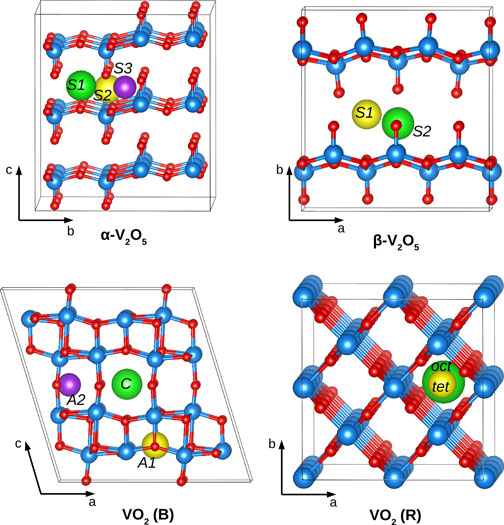Crossref Citations
This article has been cited by the following publications. This list is generated based on data provided by
Crossref.
Kulish, Vadym
Koch, Daniel
and
Manzhos, Sergei
2017.
Insertion of Mono- vs. Bi- vs. Trivalent Atoms in Prospective Active Electrode Materials for Electrochemical Batteries: An ab Initio Perspective.
Energies,
Vol. 10,
Issue. 12,
p.
2061.
Koch, Daniel
and
Manzhos, Sergei
2018.
First-Principles Study of the Calcium Insertion in Layered and Non-Layered Phases of Vanadia.
MRS Advances,
Vol. 3,
Issue. 60,
p.
3507.
Zhu, Yun-Hai
Zhang, Qi
Yang, Xu
Zhao, En-Yue
Sun, Tao
Zhang, Xin-Bo
Wang, Sai
Yu, Xi-Qian
Yan, Jun-Min
and
Jiang, Qing
2019.
Reconstructed Orthorhombic V2O5 Polyhedra for Fast Ion Diffusion in K-Ion Batteries.
Chem,
Vol. 5,
Issue. 1,
p.
168.
Chen, Yingqian
Cho, Chae-Ryong
and
Manzhos, Sergei
2019.
Lithium Attachment to C60 and Nitrogen- and Boron-Doped C60: A Mechanistic Study.
Materials,
Vol. 12,
Issue. 13,
p.
2136.
Koch, Daniel
and
Manzhos, Sergei
2019.
A Comparative First-Principles Study of Lithium, Sodium and Magnesium Insertion Energetics in Brookite Titanium Dioxide.
MRS Advances,
Vol. 4,
Issue. 14,
p.
837.
Ye, Fangliang
Lu, Dongwei
Gui, Xuchun
Wang, Tengrui
Zhuang, Xiaoying
Luo, Wei
and
Huang, Yunhui
2019.
Atomic layer deposition of core-shell structured V2O5@CNT sponge as cathode for potassium ion batteries.
Journal of Materiomics,
Vol. 5,
Issue. 3,
p.
344.
Koch, Daniel
and
Manzhos, Sergei
2020.
Ab initiomodeling and design of vanadia-based electrode materials for post-lithium batteries.
Journal of Physics D: Applied Physics,
Vol. 53,
Issue. 8,
p.
083001.
Koch, Daniel
and
Manzhos, Sergei
2020.
First-Principles Study of the Electrochemical Sodiation of Rutile-Type Vanadium Dioxide.
MRS Advances,
Vol. 5,
Issue. 27-28,
p.
1467.
Liu, Shude
Kang, Ling
and
Jun, Seong Chan
2021.
Challenges and Strategies toward Cathode Materials for Rechargeable Potassium‐Ion Batteries.
Advanced Materials,
Vol. 33,
Issue. 47,
Ikhe, Amol Bhairuba
2021.
Chemically Deposited Nanocrystalline Metal Oxide Thin Films.
p.
531.
Wu, Zhenrui
Zou, Jian
Chen, Shulin
Niu, Xiaobin
Liu, Jian
and
Wang, Liping
2021.
Potassium-ion battery cathodes: Past, present, and prospects.
Journal of Power Sources,
Vol. 484,
Issue. ,
p.
229307.
Li, Wen
Bi, Zimo
Zhang, Wenxin
Wang, Jian
Rajagopalan, Ranjusha
Wang, Qiujun
Zhang, Di
Li, Zhaojin
Wang, Haiyan
and
Wang, Bo
2021.
Advanced cathodes for potassium-ion batteries with layered transition metal oxides: a review.
Journal of Materials Chemistry A,
Vol. 9,
Issue. 13,
p.
8221.
Fu, Qiang
Sarapulova, Angelina
Zhu, Lihua
Melinte, Georgian
Missyul, Alexander
Welter, Edmund
Luo, Xianlin
Knapp, Michael
Ehrenberg, Helmut
and
Dsoke, Sonia
2021.
In operando study of orthorhombic V2O5 as positive electrode materials for K-ion batteries.
Journal of Energy Chemistry,
Vol. 62,
Issue. ,
p.
627.
Khan, Muhammad Isa
Anwar, Maida
Majid, Abdul
Shakil, Muhammad
and
Rizwan, Muhammad
2022.
Computational Studies of Super-B as Anodes for AM (Li, Na, and K) Ion Batteries.
Journal of The Electrochemical Society,
Vol. 169,
Issue. 9,
p.
090514.
Zhu, Yun-Hai
Wang, Jia-Zhi
Zhang, Qi
Cui, Yang-Feng
Huang, Gang
Yan, Jun-Min
and
Zhang, Xin-Bo
2022.
Creation of a rigid host framework with optimum crystal structure and interface for zero-strain K-ion storage.
Energy & Environmental Science,
Vol. 15,
Issue. 4,
p.
1529.
Wu, Yuhan
Chen, Guangbo
Wu, Xiaonan
Li, Lin
Yue, Jinyu
Guan, Yinyan
Hou, Juan
Shi, Fanian
and
Liang, Jiyan
2023.
Research progress on vanadium oxides for potassium-ion batteries
.
Journal of Semiconductors,
Vol. 44,
Issue. 4,
p.
041701.
Fu, Qiang
Zhao, Hainan
Sarapulova, Angelina
and
Dsoke, Sonia
2023.
V2O5 as a versatile electrode material for postlithium energy storage systems.
Applied Research,
Vol. 2,
Issue. 3,
Alcántara, Ricardo
Lavela, Pedro
Edström, Kristina
Fichtner, Maximilian
Le, Top Khac
Floraki, Christina
Aivaliotis, Dimitris
and
Vernardou, Dimitra
2023.
Metal-Ion Intercalation Mechanisms in Vanadium Pentoxide and Its New Perspectives.
Nanomaterials,
Vol. 13,
Issue. 24,
p.
3149.
Wu, Lichen
Fu, Hongwei
Li, Shu
Zhu, Jian
Zhou, Jiang
Rao, Apparao M.
Cha, Limei
Guo, Kunkun
Wen, Shuangchun
and
Lu, Bingan
2023.
Phase-engineered cathode for super-stable potassium storage.
Nature Communications,
Vol. 14,
Issue. 1,
Yaseen, Muhammad Waseem
Maman, Manju P.
Mishra, Shashank
Mohammad, Ibrahim
and
Li, Xuefei
2024.
Strategies to alleviate distortive phase transformations in Li-ion intercalation reactions: an example with vanadium pentoxide.
Nanoscale,
Vol. 16,
Issue. 20,
p.
9710.
